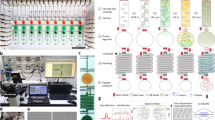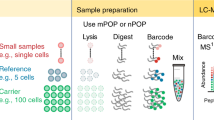Abstract
This paper describes a microproteomic workflow that is useful for simultaneously identifying and quantifying proteins from a minimal number of morphotypically heterogeneous cultured adherent cells. The analytical strategy makes use of laser capture microdissection, an effective means of harvesting pure cell populations, and label-free mass spectrometry. We optimised the workflow with particular reference to cell fixation which is crucial for successful laser-based microdissection and also downstream molecular studies. In addition, we defined the minimum number of cells to be isolated and analysed for satisfactory proteome coverage. To set up this workflow, we choose human monocyte-derived macrophages spontaneously differentiated in vitro. These cells, under our culture conditions, show distinct morphotypes, reminiscent of the heterogeneity observed in tissues in various homeostatic and pathological states, e.g. atherosclerosis. This optimised workflow may provide new insights into biology and pathology of heterogeneous cell in culture, particularly when other cell selection approaches are not suitable.

ᅟ





Similar content being viewed by others
References
Teruel MN, Meyer T (2002) Parallel single-cell monitoring of receptor-triggered membrane translocation of a calcium-sensing protein module. Science 295(5561):1910–1912
Kurimoto K, Yabuta Y, Ohinata Y, Saitou M (2007) Global single-cell cDNA amplification to provide a template for representative high-density oligonucleotide microarray analysis. Nat Protoc 2(3):739–752
Gutstein HB, Morris JS, Annangudi SP, Sweedler JV (2008) Microproteomics: analysis of protein diversity in small samples. Mass Spectrom Rev 27(4):316–330
Mustafa D, Kros JM, Luider T (2008) Combining laser capture microdissection and proteomics techniques. Methods Mol Biol 428:159–178
Zhou G, Li H, DeCamp D, Chen S, Shu H, Gong Y, Flaig M, Gillespie JW, Hu N, Taylor PR, Emmert-Buck MR, Liotta LA, Petricoin EF 3rd, Zhao Y (2002) 2D differential in-gel electrophoresis for the identification of esophageal scans cell cancer-specific protein markers. Mol Cell Proteomics 1(2):117–124
Jain KK (2002) Recent advances in oncoproteomics. Curr Opin Mol Ther 4(3):203–209
Palmer-Toy DE, Sarracino DA, Sgroi D, LeVangie R, Leopold PE (2000) Direct acquisition of matrix-assisted laser desorption/ionization time-of-flight mass spectra from laser capture microdissected tissues. Clin Chem 46(9):1513–1516
Shapiro JP, Biswas S, Merchant AS, Satoskar A, Taslim C, Lin S, Rovin BH, Sen CK, Roy S, Freitas MA (2012) A quantitative proteomic workflow for characterization of frozen clinical biopsies: laser capture microdissection coupled with label-free mass spectrometry. J Proteome 77:433–440
Liu NQ, Braakman RB, Stingl C, Luider TM, Martens JW, Foekens JA, Umar A (2012) Proteomics pipeline for biomarker discovery of laser capture microdissected breast cancer tissue. J Mammary Gland Biol Neoplasia 17(2):155–164
Wiener MC, Sachs JR, Deyanova EG, Yates NA (2004) Differential mass spectrometry: a label-free LC-MS method for finding significant differences in complex peptide and protein mixtures. Anal Chem 76(20):6085–6096
Old WM, Meyer-Arendt K, Aveline-Wolf L, Pierce KG, Mendoza A, Sevinsky JR, Resing KA, Ahn NG (2005) Comparison of label-free methods for quantifying human proteins by shotgun proteomics. Mol Cell Proteomics 4(10):1487–1502
Silva JC, Denny R, Dorschel CA, Gorenstein M, Kass IJ, Li GZ, McKenna T, Nold MJ, Richardson K, Young P, Geromanos S (2005) Quantitative proteomic analysis by accurate mass retention time pairs. Anal Chem 77(7):2187–2200
Eligini S, Crisci M, Bono E, Songia P, Tremoli E, Colombo GI, Colli S (2013) Human monocyte-derived macrophages spontaneously differentiated in vitro show distinct phenotypes. J Cell Physiol 228(7):1464–1472
Murray PJ, Wynn TA (2011) Protective and pathogenic functions of macrophage subsets. Nat Rev Immunol 11(11):723–737
Bradford MM (1976) A rapid and sensitive method for the quantitation of microgram quantities of protein utilizing the principle of protein-dye binding. Anal Biochem 72:248–254
Bagnato C, Thumar J, Mayya V, Hwang SI, Zebroski H, Claffey KP, Haudenschild C, Eng JK, Lundgren DH, Han DK (2007) Proteomics analysis of human coronary atherosclerotic plaque: a feasibility study of direct tissue proteomics by liquid chromatography and tandem mass spectrometry. Mol Cell Proteomics 6(6):1088–1102
Silva JC, Gorenstein MV, Li GZ, Vissers JP, Geromanos SJ (2006) Absolute quantification of proteins by LCMSE: a virtue of parallel MS acquisition. Mol Cell Proteomics 5(1):144–156
Li GZ, Vissers JP, Silva JC, Golick D, Gorenstein MV, Geromanos SJ (2009) Database searching and accounting of multiplexed precursor and product ion spectra from the data independent analysis of simple and complex peptide mixtures. Proteomics 9(6):1696–1719
Geromanos SJ, Vissers JP, Silva JC, Dorschel CA, Li GZ, Gorenstein MV, Bateman RH, Langridge JI (2009) The detection, correlation, and comparison of peptide precursor and product ions from data independent LC-MS with data dependant LC-MS/MS. Proteomics 9(6):1683–1695
Brioschi M, Lento S, Tremoli E, Banfi C (2013) Proteomic analysis of endothelial cell secretome: a means of studying the pleiotropic effects of Hmg-CoA reductase inhibitors. J Proteome 78:346–361
Levin Y, Hradetzky E, Bahn S (2011) Quantification of proteins using data-independent analysis (MSE) in simple and complex samples: a systematic evaluation. Proteomics 11(16):3273–3287
Carbon S, Ireland A, Mungall CJ, Shu S, Marshall B, Lewis S (2009) AmiGO: online access to ontology and annotation data. Bioinformatics 25(2):288–289
Hu Z, Bao J, Reecy JM (2008) CateGOrizer: a web-based program to batch analyze gene ontology classification categories. Online J Bioinforma 9(2):108–112
Rekhter MD, Chen J (2001) Molecular analysis of complex tissues is facilitated by laser capture microdissection: critical role of upstream tissue processing. Cell Biochem Biophys 35(1):103–113
Draux F, Gobinet C, Sule-Suso J, Trussardi A, Manfait M, Jeannesson P, Sockalingum GD (2010) Raman spectral imaging of single cancer cells: probing the impact of sample fixation methods. Anal Bioanal Chem 397(7):2727–2737
Vissers JP, Langridge JI, Aerts JM (2007) Analysis and quantification of diagnostic serum markers and protein signatures for Gaucher disease. Mol Cell Proteomics 6(5):755–766
Hood BL, Darfler MM, Guiel TG, Furusato B, Lucas DA, Ringeisen BR, Sesterhenn IA, Conrads TP, Veenstra TD, Krizman DB (2005) Proteomic analysis of formalin-fixed prostate cancer tissue. Mol Cell Proteomics 4(11):1741–1753
Espina V, Wulfkuhle JD, Calvert VS, VanMeter A, Zhou W, Coukos G, Geho DH, Petricoin EF 3rd, Liotta LA (2006) Laser-capture microdissection. Nat Protoc 1(2):586–603
Rubakhin SS, Greenough WT, Sweedler JV (2003) Spatial profiling with MALDI MS: distribution of neuropeptides within single neurons. Anal Chem 75(20):5374–5380
Acknowledgments
This work was supported by the Italian Ministry of Health, Rome, Italy (Ricerca Corrente 2011, BIO 06).
Author information
Authors and Affiliations
Corresponding author
Additional information
Maura Brioschi and Sonia Eligini contributed equally to this work.
Electronic supplementary material
Below is the link to the electronic supplementary material.
ESM 1
(PDF 11596 kb)
Rights and permissions
About this article
Cite this article
Brioschi, M., Eligini, S., Crisci, M. et al. A mass spectrometry-based workflow for the proteomic analysis of in vitro cultured cell subsets isolated by means of laser capture microdissection. Anal Bioanal Chem 406, 2817–2825 (2014). https://doi.org/10.1007/s00216-014-7724-9
Received:
Revised:
Accepted:
Published:
Issue Date:
DOI: https://doi.org/10.1007/s00216-014-7724-9




